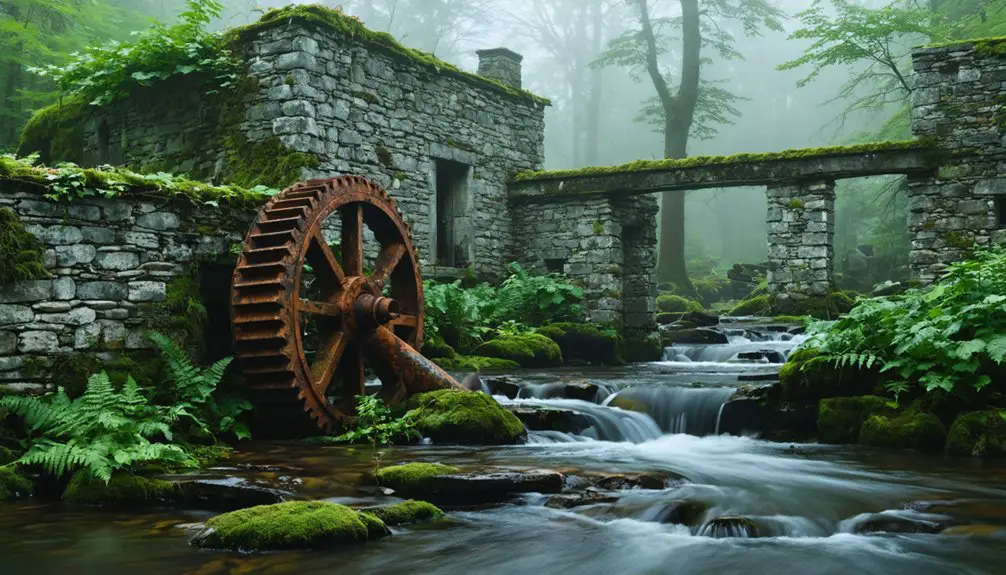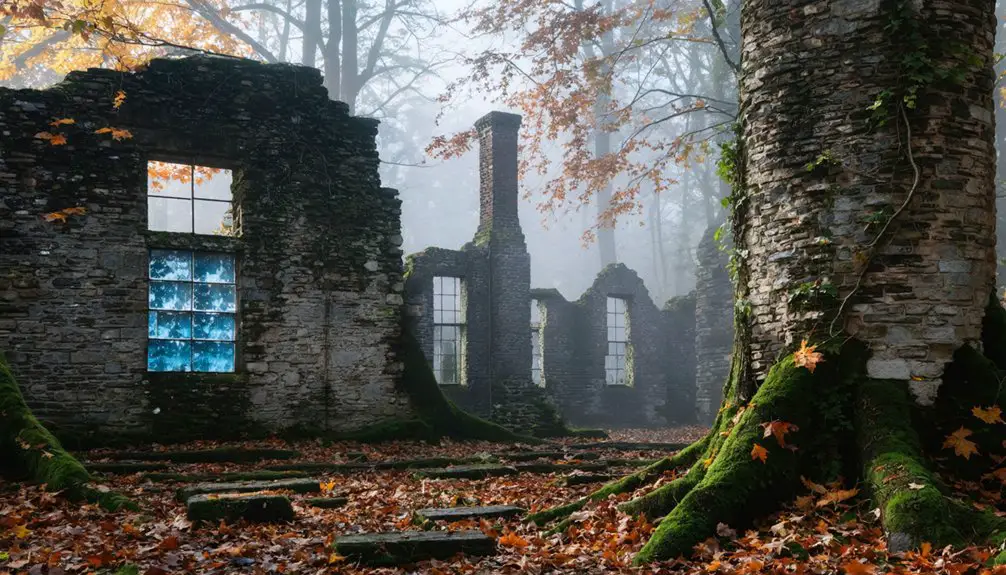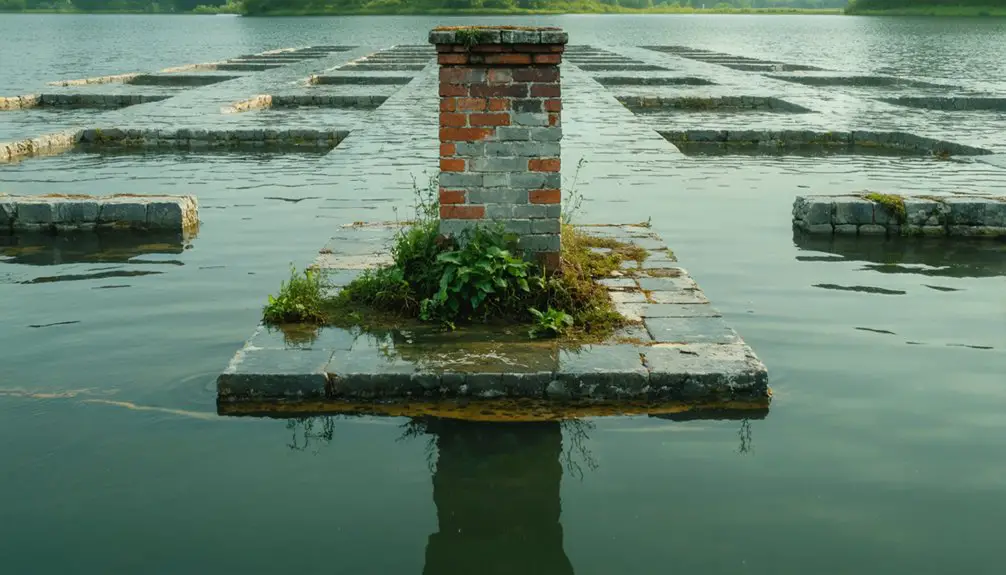You’ll find Questing, a colonial ghost town nestled in the Berkshire Mountains of Massachusetts, where the Leffingwell and Brookins families once thrived in the 1700s. The 438-acre site features remnants of early settlements, including stone walls and cellar holes from the Leffingwell farmstead. By the late 1800s, economic hardship led to its abandonment. Now a nature reserve, the site’s Leffingwell Loop trail reveals fascinating traces of colonial life beneath the reclaimed forest.
Key Takeaways
- Questing, formerly known as “Dogtown,” is a ghost town in the Berkshires of Massachusetts with roots dating to the 1700s.
- The abandoned settlement features the historic Leffingwell farmstead ruins, including visible cellar holes and stone walls from colonial times.
- Economic hardship and the deaths of the Leffingwell brothers led to the town’s abandonment in the late 1800s.
- The site is now a 438-acre nature reserve managed by The Trustees of Reservations, accessible via New Marlborough Hill Road.
- Visitors can explore approximately 2 miles of hiking trails, including the Leffingwell Loop, to view historical remnants and archaeological sites.
The Lost Village of Leffingwell Hill
Nestled within the Questing Reservation in New Marlborough, Massachusetts, Leffingwell Hill stands as a haunting symbol to early colonial settlement in the Berkshires.
Perched high in the Berkshire hills, Leffingwell’s abandoned grounds echo the haunting legacy of Massachusetts’ colonial past.
You’ll discover a rich Leffingwell history spanning back to the 1700s, when the first non-Native American children in the region were born within a fortified refuge built by early settlers. These twin girls were born to Philip and Mrs. Brookins who were among the earliest families to settle the area.
The site became a nature reserve in 1996, opening its historic grounds for public exploration.
As you explore the 438-acre expanse, you’ll encounter remnants of colonial agriculture: crumbling stone walls and abandoned structures dot the landscape, telling tales of the William and Jerome Leffingwell farmstead.
The settlement’s historical significance deepened when economic depression drove families westward in the late 19th century. By 1839, the village earned the mysterious nickname “Dogtown” before its final resident, Cornelius Finson, was removed from his cellar dwelling, leaving the hilltop forever deserted.
Early Settlement and Colonial Life
The untamed wilderness of Massachusetts Bay beckoned European settlers in the early 1600s, where an estimated 7,000 indigenous people from various Algonquian-speaking tribes had already established thriving communities.
You’d find the landscape transformed by the 1630s as nearly 20,000 colonists arrived, driven by promises of religious freedom and economic opportunity. The settlers engaged in fur trading and lumber industries to sustain their new colonial economy. Small-scale compact settlements characterized the growing communities.
In Questing’s early days, you’d discover fortified settlements with log-and-stone enclosures protecting colonial agriculture from potential threats.
The community governance system centered on town meetings, where every taxpayer had a voice in local decisions. These settlements followed the traditional New England pattern: a central green surrounded by clustered homes and farmland, with stone walls marking property boundaries.
The Brookins family, among the area’s first settlers, carved out a life here before economic hardship drove residents westward.
The Mysterious Fort and First Births
Among the most intriguing structures in colonial Questing stood a military fort atop Leffington Hill, built in the early 18th century as part of New Marlborough’s defensive network.
While its exact location remains elusive, local tradition places it near the brook’s edge where the trail enters the field. The 438-acre property now preserves this historic landscape for modern-day visitors to explore. You’ll find the fort’s significance deeply woven into the area’s colonial heritage, as it served as both a refuge and community hub for early settlers.
Within these fortified walls, a remarkable milestone occurred: the first non-Native American births in the Berkshires. Twin girls, born to Philip Brookins and his wife, marked a pivotal moment in the region’s settlement history.
Though the fort’s physical structure has vanished, cellar holes and stone walls still trace the footprint of this historic sanctuary.
Tales of Witchcraft and Local Legends
While Salem’s infamous witch trials cast a long shadow over colonial Massachusetts, Questing harbored its own unsettling stories of supernatural encounters and accusations.
During the height of witchcraft history in 1692, you’d have found local families turning against their neighbors, with testimonies based on spectral evidence and claims of mysterious afflictions.
Like Salem, Questing’s residents lived in fear of supernatural forces, believing witches had made pacts with the Devil to torment good Christians. The strong influence of Puritan religious beliefs shaped how colonists viewed and responded to suspected witchcraft.
Though no executions occurred in Questing itself, several townspeople faced accusations, imprisonment, and social ruin. The harsh conditions of colonial jails, with their dirt floors and poor ventilation, made imprisonment a severe punishment even without conviction.
Local folklore tells of secret gatherings deep in the woods where folk magic practitioners would meet, distinct from the malevolent witchcraft that terrified the colonists.
These tales persist in Questing’s abandoned ruins today.
Nature’s Reclamation of Human History
Today’s visitors to Questing’s ghost town find nature steadily erasing human traces, creating a stark contrast to its haunted colonial past.
Through natural succession, forests have reclaimed abandoned homesteads, with moss-covered stone walls and cellar holes now blending into the landscape. You’ll discover thriving ecosystems where farms once stood – warblers nest in hardwood canopies, butterflies dance through meadows, and diverse wildlife roams freely through the property’s varied habitats.
The land has achieved remarkable ecological balance since its abandonment. Former agricultural soils have regenerated, while seasonal vernal pools support critical wetland species.
What remains of human settlement serves nature’s purpose: old paths create wildlife corridors, and crumbling foundations provide shelter for small mammals.
You’re witnessing the quiet triumph of wilderness over civilization.
Preserving the Past: Archaeological Remnants
Beneath the forest’s understory, Questing’s colonial heritage endures through an array of archaeological remnants scattered across the 438-acre reservation.
You’ll discover stone walls and cellar holes that mark where the Leffingwell family once lived, offering glimpses into 18th and 19th-century colonial life.
While exploring the Leffingwell Loop trail, you’ll encounter evidence of early American settlement:
Walking the Leffingwell Loop reveals traces of America’s colonial past, where stone ruins whisper stories of early settlers.
- Field stone foundations revealing house footprints and outbuilding locations
- Historic stone walls defining colonial-era property boundaries and pastures
- Cellar holes near a brook, traditionally linked to an early 18th-century log-and-stone fort
The Trustees of Reservations now protect these archaeological treasures, maintaining them for future generations while allowing you to freely explore this preserved slice of New England’s past through designated hiking trails.
Seasonal Activities and Wildlife Encounters
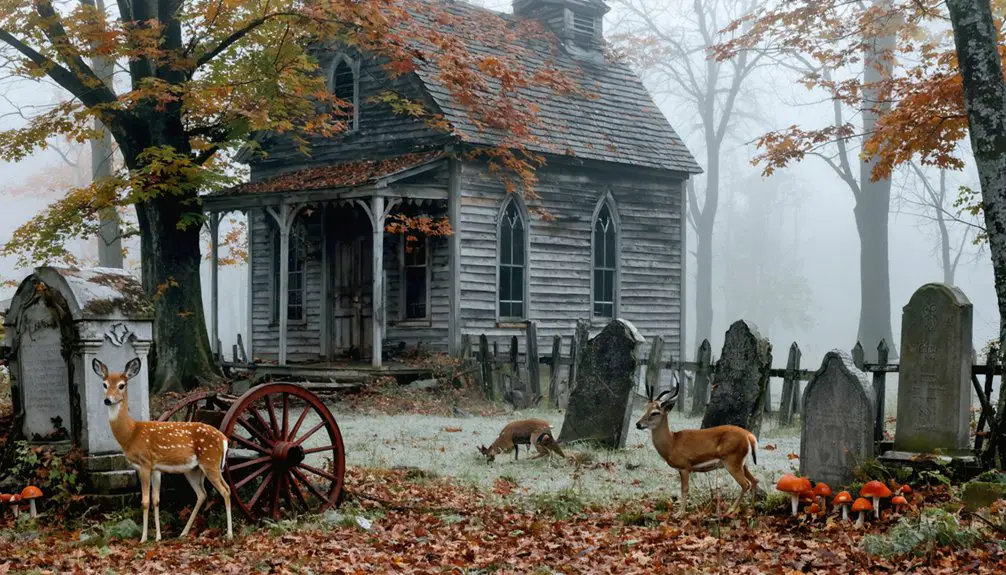
You’ll find spectacular fall foliage views along the Leffingwell Loop trail, where golden-crowned kinglets dart through the vibrant autumn canopy.
In winter months, you can explore over two miles of snow-covered trails via cross-country skiing or snowshoeing while tracking wildlife prints in the pristine powder.
During summer afternoons, the open meadows transform into prime butterfly watching spots, where you can observe numerous pollinators amid the seasonal wildflowers.
Fall Foliage Viewing Hotspots
Perched atop Leffingwell Hill, Questing’s 438-acre hardwood forest transforms into a stunning kaleidoscope of fall colors, offering visitors multiple vantage points to witness New England’s iconic autumn display.
The Brothers’ farm site, established in the mid-1800s, provides a unique historical backdrop for viewing the changing leaves.
You’ll discover the most vibrant fall color along the Leffingwell Loop trail, where a 250-foot elevation gain rewards you with panoramic views of the forest canopy.
The moderate hiking trails stretch for two miles through the diverse terrain, offering accessible paths for visitors of all skill levels.
For the best foliage viewing experiences, head to these prime locations:
- The half-mile connector trail, where changing hardwoods create a natural tunnel of red and gold
- Open meadows with 17 acres of wildflowers contrasting against the forested backdrop
- Historic cellar holes and stone walls, where colonial ruins frame the autumn spectacle
Take advantage of numerous photography spots as you explore these hiking trails through Questing’s untamed landscape.
Winter Trail Adventures
When winter blankets Questing’s forest trails in snow, the 438-acre reservation transforms into a pristine playground for cold-weather adventurers.
You’ll find pristine cross-country skiing trails winding through varied terrain, while snowshoeing lets you explore secluded forest paths and meadows where historic stone walls peek through the snow.
As you trek along the marked routes from New Marlborough Hill Road, you’ll spot tracks of winter wildlife like foxes, deer, and even bobcats in fresh powder.
Keep your eyes peeled for golden-crowned kinglets and nuthatches flitting through bare branches.
Remember to wear bright colors during hunting season and pack proper winter gear – conditions can change quickly.
You won’t find any snowmobiles here; the ban on motorized vehicles guarantees you’ll experience nature’s quiet splendor undisturbed.
Summer Butterfly Watching
As winter’s white canvas melts away, Questing’s diverse butterfly population emerges to paint the landscape with vibrant wings from June through October.
You’ll discover over 100 species displaying fascinating butterfly behavior across the town’s varied habitats, from moist woodland edges to sunny meadows.
- Track Red Admirals as they feast on fermented fruit – they’re so calm they might even land on you
- Explore wetlands to spot rare Two-spotted Skippers among specialized nectar sources
- Watch for Eastern Commas showcasing different summer and winter wing patterns
For the best viewing experience, visit meadows rich with black-eyed Susans, asters, and milkweed during peak summer flights.
You’ll find particularly active populations near American Elm stands and nettle patches, where many species lay their eggs and feed their caterpillars.
Keep an eye out for Question Mark butterflies feeding on sap and rotting fruit, often congregating in small groups near damaged trees.
The Journey From Settlement to Abandonment
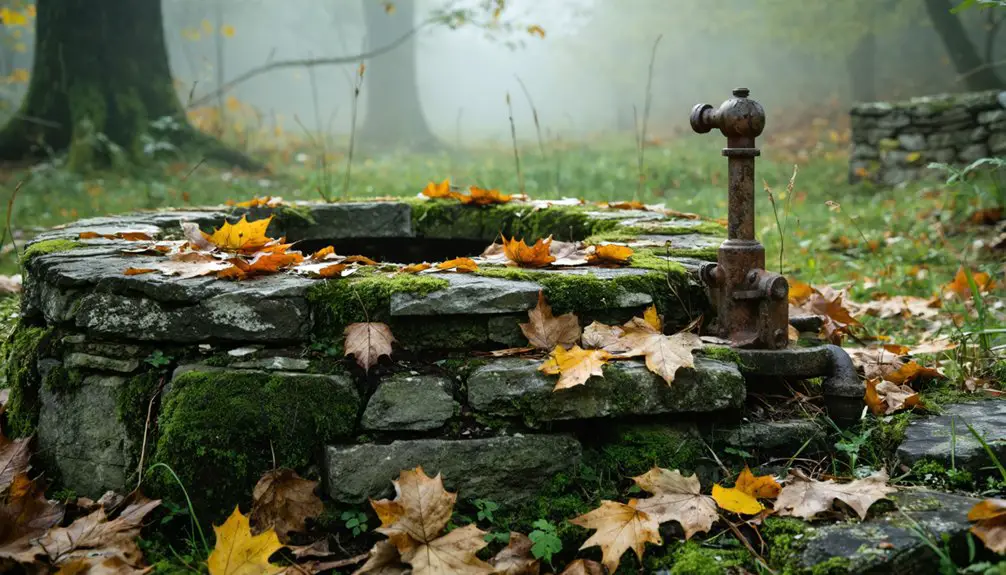
As you walk Questing’s trails today, you’re tracing the footsteps of the Brookins family who established one of the earliest colonial settlements in the Berkshires, complete with a strategic fort near the brook on Leffingwell Hill.
You’ll find the remnants of the once-thriving Leffingwell farmstead, where generations worked the land until tragedy and economic hardship forced families westward in the late 1800s.
The site’s transformation from frontier settlement to the Leffingwell family’s agricultural venture, and finally to its abandonment in 1839, tells a story common to many New England ghost towns where changing fortunes left only stone walls and cellar holes as evidence of earlier lives.
Early Colonial Life
Though life in colonial Massachusetts presented numerous challenges, the settlement of Questing began promisingly in the early 1700s atop Leffingwell Hill. The settler communities established a fortified log-and-stone fort as their refuge, while surrounding fields showcased their commitment to colonial agriculture through carefully crafted stone walls and fieldstone foundations.
You’ll find these early settlers were resourceful and determined:
- They built homes strategically placed near brooks and meadows.
- They created a self-sufficient community focused on subsistence farming.
- They constructed strong defensive positions, including the fort where Mrs. Brookins delivered the Berkshires’ first non-Native American twins.
The settlement’s layout reflected both practicality and protection, with houses and outbuildings positioned to maximize farming efficiency while maintaining security against potential threats.
Rise and Fall
When William and Jerome Leffingwell established their farm on Leffingwell Hill in the 1700s, they couldn’t have predicted their settlement’s eventual fate.
The agricultural community grew steadily around their farmstead, with stone walls and cellar holes marking the boundaries of a thriving village. Yet this cultural significance would be short-lived.
Economic factors in the late 1800s triggered Questing’s downfall. As regional depression set in, settlers abandoned their homes for promising opportunities in the Midwest. The tragic deaths of both Leffingwell brothers in farming accidents accelerated the exodus.
Legends and Lore
Three haunting tales emerged from Questing‘s transformation into a ghost town, each rooted in the site’s colonial past.
You’ll find spectral sightings tied to the tragic deaths of the Leffingwell brothers on their farmstead, while haunting encounters with alleged witches from nearby Dogtown have left their mark on local folklore.
- The Brookins twins, first colonial children born in the Berkshires, are said to still play near the old fort site on Leffington Hill.
- Former outcasts and drifters who squatted in abandoned homes reportedly cast curses on passersby.
- The spirit of Cornelious Finson, Dogtown’s last resident who died shortly after forced removal, is believed to wander the preserve’s stone walls.
These stories gained momentum after Dr. Lehman renamed the area “Questing,” inspired by Arthurian mythology.
Modern Conservation and Public Access
Today’s Questing Reservation encompasses 438 acres of protected open space in New Marlborough, Massachusetts, managed by The Trustees of Reservations.
Through conservation practices established after land gifts in 1992 and 1996, you’ll find a thoughtfully preserved landscape that balances historic features with natural recovery.
You can access the property via New Marlborough Hill Road, where you’ll discover approximately 2 miles of moderate hiking trails, including the main Leffingwell Loop.
The trail system leads you through diverse habitats and up a 250-foot forest climb to scenic meadow viewpoints.
While motorized vehicles and bicycles aren’t allowed, you’re welcome to explore on foot, snowshoes, or cross-country skis.
The property’s public engagement initiatives focus on maintaining native plant communities while protecting colonial-era remnants like cellar holes and stone walls.
Frequently Asked Questions
Are There Any Documented Paranormal Investigations Conducted at Questing?
You won’t find any official ghostly encounters or investigation reports from Questing, as paranormal research teams haven’t documented investigations there. Nearby Salem and Boston attract most ghost-hunting activities in Massachusetts.
What Happened to the Original Artifacts Found Within the Settlement Area?
You’ll find most original artifacts remain integrated into the landscape – mainly cellar holes and stone walls. While artifact preservation efforts focus on these structural remains, there’s no record of portable items being curated elsewhere.
How Many Families Originally Lived in the Questing Settlement?
Like pioneers seeking their manifest destiny, you’ll find settlement demographics were sparse – primarily the Leffingwell brothers’ family lineage and a handful of related households, though exact numbers remain historically uncertain.
Were Any Indigenous Artifacts Discovered in the Questing Area?
You won’t find documented indigenous artifacts at Questing in existing records. While the Berkshires have rich indigenous history, no formal artifact preservation or archaeological discoveries have been reported at this specific location.
What Caused the Unusual Name “Questing” to Be Chosen?
You’ll find the name origin stems from Dr. Robert Lehman’s 1970s choice, inspired by the Arthurian Questing Beast, a legendary creature that transformed local legends into a symbol of mystical pursuit.
References
- https://historyofmassachusetts.org/ghost-towns-massachusetts/
- https://en.wikipedia.org/wiki/Questing_(New_Marlborough
- https://westernmasshilltownhikers.com/2024/03/04/questing-in-new-marlborough/
- https://thetrustees.org/place/questing/
- https://berkshiresoutside.org/place/questing-reservation-new-marlborough-ma/
- https://thelastgreenvalley.org/wp-content/uploads/2014/09/NandN.pdf
- https://en.wikipedia.org/wiki/Massachusetts_Bay_Colony
- https://www.sec.state.ma.us/divisions/cis/historical/historical-sketch.htm
- https://www.weymouth.ma.us/history/pages/first-hundred-years
- https://en.wikipedia.org/wiki/List_of_ghost_towns_in_Massachusetts
